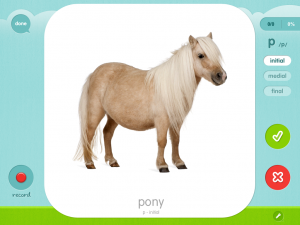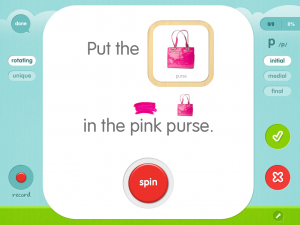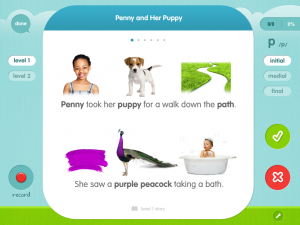Articulation Station App Review
Articulation Station is a comprehensive articulation app that I use quite a bit in therapy. You can choose to purchase each consonant deck separately to save on cost. As you can see from this screen shot, I haven’t purchased all of the sounds myself; however, I did purchase ‘l’ ‘r’ and ‘s’ because those decks also contain blends, which I do use a lot in therapy.
I chose ‘P’ for the purposes of showing you all the things you can do with this app. First, you can choose to work on the sound in three different contexts: word, sentence, or story level.
 At the word level, you can choose flashcards or choose to play a matching game.
At the word level, you can choose flashcards or choose to play a matching game.
Once you’ve chosen your activity, you can isolate a sound position: initial, medial, or final. There is also an option to sort the words in ascending syllable complexity. The app allows you to collect data by touching the green check or red X buttons seen on the left, and automatically calculates a percentage and puts it into a chart that you can email to yourself. There is also an option to calculate word approximations that you can turn on in the settings menu if you choose. I’ve used this option with my kids who have difficulty with ‘r.’
The is a group setting option that allows you to use this app with more than one child which is nice from an SLP perspective. The kids’ names will be shown at the top in little tabs (not pictured here) if you are working with a group.
The second option allows the child to practice the words in a sentence. There is an option to rotate the words in one sentence seen on the left (rotating) or to practice the words in a different sentence (unique). The first option is nice for my kids who may not be strong readers, but are at the sentence level in practicing their speech sounds, because they can remember the sentence and still get practice saying their sounds by reading at the sentence level. The second option is equally as nice for my stronger readers to practice saying their words correctly in a variety of sentences, promoting greater carryover. However, I can still use it with my younger kiddos because there is always an option to press the screen, and the words/sentences/stories will be read for them first allowing them to repeat if necessary.
Finally, there is a third setting for stories. Once again, you have two options to choose from in this setting as well: Level 1 and Level 2. Level 1 has a the story set in a rebus or picture format (on left) to help beginning readers practice their target sounds at a story level. Level 2 is for a more proficient reader, and includes the target words in text. As mentioned above, there is always the option to touch the screen and have it read first if necessary. The story modes also have comprehension questions at the end, which works on receptive language, but also requires the child to use one of the target sounds in their answer. This is also great to promote carryover, because it helps the child practice saying their sounds in a spontaneous production.
Other features this app includes is a record/playback function, which is personally a must have for me. I think it’s powerful to have the kids hear themselves say it. Depending on their level, I might also have them score themselves.
You can also modify the word lists, and include your own custom images. However, custom images are only available if you have all the sound decks.
Pros: Honestly, this is one of my favorite articulation therapy apps. It contains almost every feature I can think of, with the option to turn any of them off or on depending on your preference. I love the pictures, I like all the options, I like the ability to scaffold the sound productions for one syllable words all the way up to the story level, and to be able to put them in the varying positions of the words.
Cons: For me, there aren’t really any cons for me. If I was being picky, it would be nice if the kids could make a profile that included their picture, but they usually recognize their name, so this isn’t a deal breaker. There also isn’t really a game or little reward, but the app is so colorful with interesting pictures and lots going on that my kids don’t seem to mind or get bored.
Since a lot of my readers deal with apraxia, I have to say I don’t feel like this is the best app for apraxia, especially for those kids in the early CV, VC stages of production. It doesn’t contain a lot of words with these basic syllable shapes, and it doesn’t have options for blocked practice like the apraxia apps will. However, it’s important to note this app isn’t marketed as an apraxia app either. It’s marketed as an articulation app, and I think for that purpose, it’s fantastic. In fact, it’s probably my favorite.
I would definitely recommend this app for SLP’s and parents to use with kids who have articulation and phonological processing delays.


